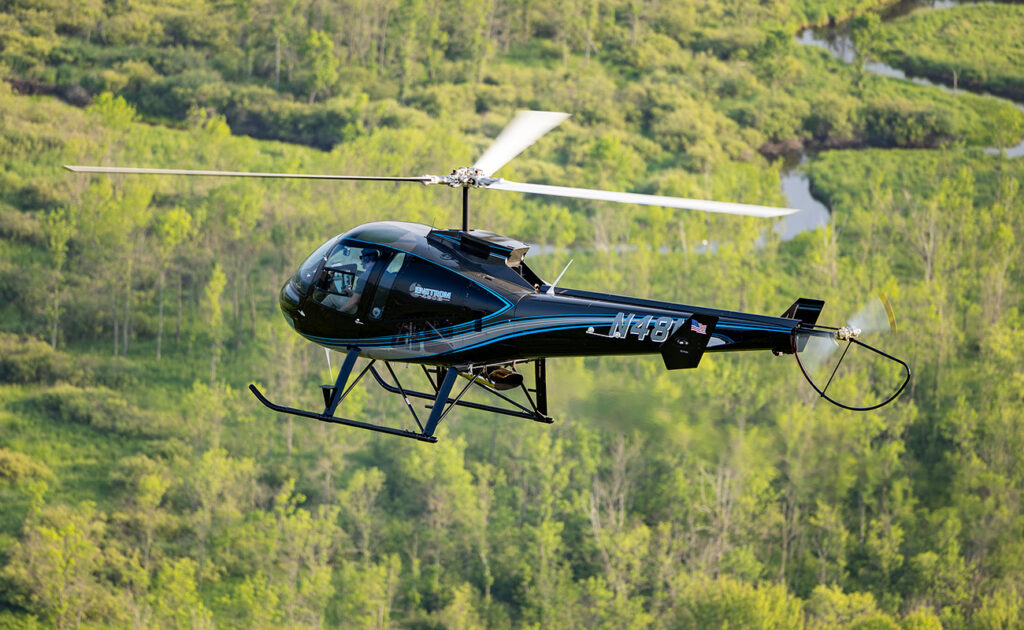Tips for Flying the Trim without Fear

I recently had the privilege of ferrying a 280FX from the factory in Menominee to Cleveland, Ohio. Smooth air and cool temps made for a nice ride as we swung around Chicago and headed east. However, even with the tailwinds, it was still a six-hour flight. It’s flights like this where I really appreciate the Enstrom trim.
Trim, for those who are unfamiliar, are secondary controls that adjust the main controls and counter aerodynamic forces to keep the helicopter at a set attitude. Enstrom stands out among light helicopter models in this regard, offering electromechanical longitudinal and lateral trim. An Enstrom pilot can utilize the “coolie hat” switch on the cyclic to quickly trim out any stick forces. When you trim, the cyclic then tends to hold that position.

I find this incredibly helpful because it dramatically lowers the workload for the pilot. Want to go 90 knots? No problem! Just trim it for 90, and you can expect the helicopter to stay there.
You’ll find all the trim modules under the helicopter floor. Electric motors turn a jackscrew, which in turn, pulls on springs, which then pulls on the control rods. If this isn’t the effect you want, it’s easy to override the trim, but you’ll be pushing up against the springs.

Flying out of trim is tiring, so we encourage Enstrom pilots to trim aggressively. In fact, experienced Enstrom pilots learn to “fly the trim.” As soon as I pick up, I trim for a stable hover. For hover taxi, I beep the trim forward a bit. Then to depart, I’ll just add in forward and right trim until the helicopter flies itself away.
Don’t be too worried about wearing out the trim. Enstrom trim motors are incredibly powerful and will last for thousands of hours. As a matter of fact, the old F28A model Enstrom I learned to fly in had racked up more than 11,000 hours. It might have sounded like someone was rattling a coffee can full of ball bearings beneath my seat, but the trim still worked!
Trim failures are rare, but they do happen. Most trim failures begin with a popped circuit breaker. If this ever happens to you, don’t reset the breaker! Instead, fly to the nearest airport and have someone look at it.
We take this very seriously at Enstrom. We even wrote it into the flight manual that you cannot reset the tripped breaker during a flight. I popped a trim breaker during my commercial checkride. Rather than just reset it and finish the checkride, I chose to stop the ride and have it checked. Why? Because a trim failure can often lead to a trim runaway.
Yes, trim failures are annoying, but trim runaways can ruin your day. A trim runaway happens when the contacts in the trim relays begin to arc and weld shut, causing the motor to run all the way in one direction. If it runs aft or right, the actuator will bottom out, and the pilot will face heavy stick forces for the remainder of the flight. If the trim runs forward or left, the helicopter becomes much more difficult to control.
If you ever notice the trim running away or actuating on its own, pull the circuit breaker immediately! Seriously, don’t waste a second. I’ve seen some pilots put a colored collar on the trim circuit breaker to help quickly identify it. Service Directive Bulletin T-039 and 110 directly address trim runaways, so if you haven’t completed this SDB for your helicopter, contact your mechanic right away.
Most pilots will go their entire flying career without experiencing a trim failure or runaway. Fortunately, if you do experience one, the repairs are quick and simple. When I faced that trim failure on my checkride, the examiner and I just took a break for lunch while the guys in the shop swapped in a new set of relays. I was then able to finish my checkride that same afternoon.
So go ahead, use that trim on your next flight and enjoy your smooth, stable ride inside an Enstrom!
Dennis Martin is the Chief Commercial Officer for Enstrom Helicopter Corporation. He has been with Enstrom for more than 14 years, working in both sales and engineering, and has traveled to over 25 different countries. Dennis is a commercial-rated rotary and fixed-wing pilot, as well as an A&P/IA.
About Enstrom Helicopter
From Rudy Enstrom’s early designs in 1943 to initial testing in a Michigan Quarry in 1957 to aircraft operating on six continents, Enstrom Helicopter Corporation has maintained a reputation for safety, value and performance. Based in Menominee, Michigan and proudly made in the United States, Enstrom has a rich history for design innovation. The goal is to provide helicopters to the customer’s exact specification and deliver support and maintenance worldwide.